2 PROS and CONS of global cooling
Positive Aspects of Global Warming
So, I’ve long wanted to write an article that would dispel yet another myth imposed on us by the media, namely that GLOBAL WARMING is TERRIBLE.
Well, here’s the thing: global warming is one of the few things humans have done that’s actually good for the nature of planet Earth )) and now I’ll explain in detail why this is so.
The critique is based on a Wikipedia article where the authors push a false narrative that “warming is bad.” And now we’ll break down who it’s bad for and who it’s good for.
Here are the arguments FOR global warming.
Argument #1: If the Media Says Something, It Benefits Someone
Media outlets, in the vast majority, survive on the money of those who’ve bought them. And they promote the interests of those who’ve bought them. So, who benefits from burdening the entire population of Earth (well, except those who are used to seeing a catch in every media statement?) with guilt? And the desire to consume less? Leaving this terrible endeavor to the top 10% of the richest people, who are responsible for 60% of carbon emissions.
This agenda, dear reader, is directed AGAINST you, just like 99.9% of what the media writes.
Argument #2: Humans Need a Warmer Climate to Feel Good and Be Productive
It seems like there’s no need to prove this—most tourism flows are from north to south. Few people want to vacation in the tundra, swatting away mosquitoes, and most would prefer to relax on a beach, gazing at corals in the sea.
But no, let’s prove it with numbers once again—humans are CREATED for a warm climate. We need it.
There are studies that say the peak of human productivity is at 22–25 °C. Again, these studies were likely conducted on people in regular clothing. But most people prefer to move around not in suits and shoes but in shorts, a t-shirt, and flip-flops. So, the optimum for a lightly dressed person is likely 25–27 °C. This can be easily tested—you can conduct this experiment at home right now )))
Here are a few links to studies:
https://www.frontiersin.org/journals/environmental-science/articles/10.3389/fenvs.2022.1039668/full
https://epic.uchicago.edu/news/hot-temperatures-decrease-worker-productivity-economic-output/
So, what’s the current average temperature on Earth?
The current average temperature of Earth is 14–15 °C.
That’s about 11 °C below our optimum (26–15=11). In other words, much of the Earth is simply unsuitable for normal human life unless one hides in a car, house, or office. Because living outdoors at +15 °C is very tough. Those who’ve gone on hiking trips know this. You freeze, even in the best clothing.
People love warm climates, people want to live in warm climates, and we need another +11 °C on average to feel good on Earth.
Argument #3: If Warming Is Good for Humans, Is It Bad for Nature?
Let’s figure out what’s good and bad for nature.
First, let’s define what’s good for nature.
Well, probably, we can say that indicators of what’s good for nature are the amount of biomass per unit of Earth’s surface and species diversity.
How can we understand what will happen if the average temperature on Earth rises by 10 degrees? Say, to 25 °C? Well, we have such periods in Earth’s history, and one of them is called the Eocene.
Here’s an interesting study that vividly shows the forecast on a modern map: https://www.pnas.org/doi/10.1073/pnas.1809600115
Note: The Eocene (56–33.9 million years ago) was an era of significant warming, especially during the Early Eocene Climatic Optimum (EECO, 54–49 million years ago). The climate was warmer than today, with a global average temperature of about 27 °C, and polar regions were ice-free. Tropical and subtropical conditions extended to high latitudes, as reflected in paleogeographic maps.
Check out the graphs (especially on p. 16) in the Eocene study: https://cp.copernicus.org/articles/7/603/2011/cp-7-603-2011.pdf, and it’ll immediately become clear that with such warming, most of the Earth will have zones with tropical and equatorial humid climates.
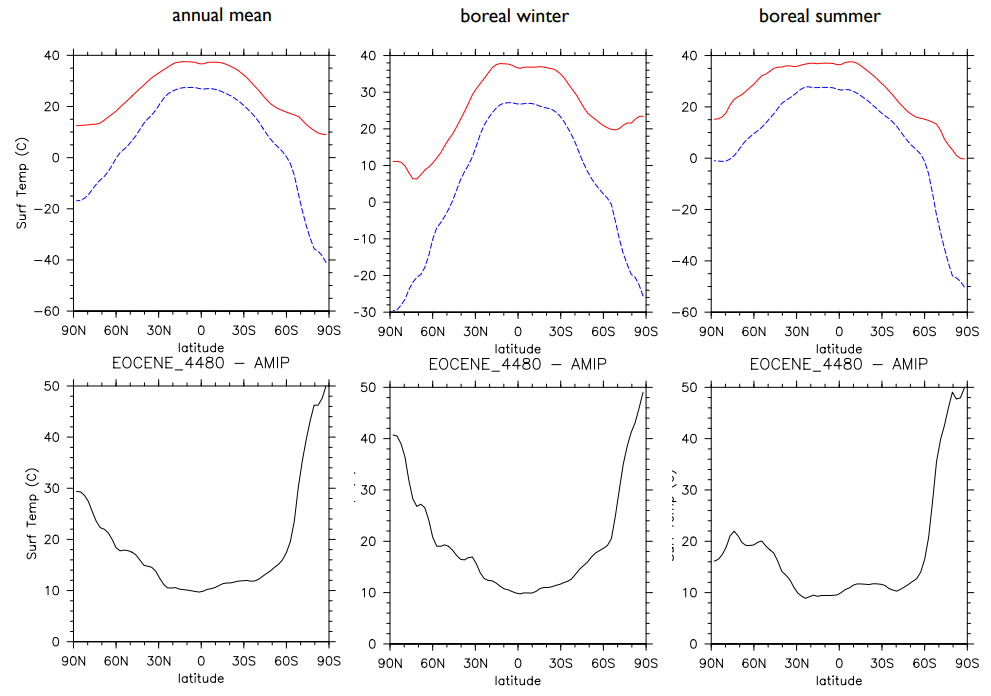
What will happen to biomass?
Biomass per square kilometer varies significantly depending on the biome. Tropical forests, located closer to the equator, have the highest biomass density, averaging 200–400 Mg/ha, equivalent to 20,000–40,000 Mg/km² (considering 1 km² = 100 ha). In contrast, tundra has much lower biomass, averaging about 3.5 Mg/ha, or 350 Mg/km², due to harsh climate and a short growing season. These data are based on global biomass maps, such as NASA ORNL DAAC maps for 2010:
https://www.sciencedirect.com/science/article/pii/S003442572500121X
That’s a 100-fold difference in biomass!
Let’s compare 15 °C and 25 °C (and for now, we’ll ignore that tropics at different latitudes will have varying biomass productivity due to less sunlight. But this will have less impact on species composition and total accumulated biomass).
| Climatic Zone | Average Number of Species per 1 km² | Total Number of Species (Approximate) |
| Tundra | 10–100 | 1500–2000 (Eurasia) |
| Temperate Zone | 100–1000 | 10,000–100,000 |
| Tropical Zone | 1000–10,000 | 1,000,000–10,000,000 |
So, biodiversity will also increase, and by orders of magnitude.
Will we cry over polar bears if, instead of them and seals, we get dozens of species (and that’s just mammals) in the same place? And it’s not a fact that we’ll lose bears and seals—they thrive at the equator too ))
Below is a table with summarized data for comparison:
| Parameter | Zone at 25 °C (Tropical) | Zone at 15 °C (Temperate) | Difference (times) |
| Species Diversity | Thousands of species/ha | Hundreds of species/ha | 5–10 |
| Biomass | 400+ tons/ha | 150–300 tons/ha | 1.3–2.7 |
| Biomass Production (NPP) | 10–20 tons/ha/year | 5–15 tons/ha/year | 0.7–4 |
| Precipitation | >2000 mm/year | 500–1500 mm/year | 1.3–4 |
So, will nature suffer?
As we can see, it will not just be GOOD—it will be WONDERFUL!
What would happen if we didn’t burn hydrocarbons?
You can look at various graphs:
https://droyer.wescreates.wesleyan.edu/Honisch_2023_Science_CenozoicCO2PIP.pdf
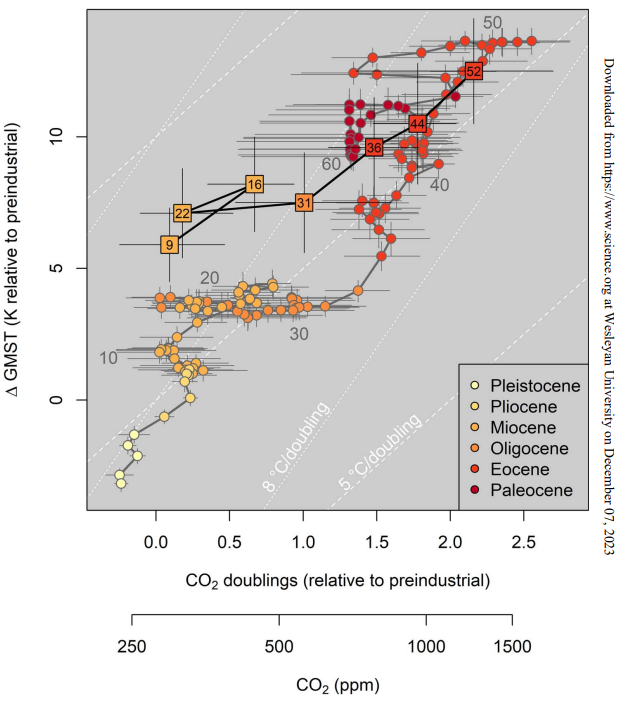
but they all say one thing: CO₂ levels and temperature, on geological timescales, have been falling for the last 60 million years, and where such declines lead, see the cartoon Ice Age.
The next scare story is “biodiversity will decrease” because many species will go extinct quickly.
And right away, I’d like to note that, from a human perspective, not all species are equally useful, and I’d gladly see the extinction of many species ))
But, no.
Yes, some will go extinct, and some will emerge. Not only because of tropical diversity but also because new ecological niches will appear.
Moreover, humans are creatures that can scientifically manage the diversity of the animal world and can preserve some of the most valuable endangered species in reserves. And some can simply be restored through genetic reconstruction, as is already being done.
Argument #4 The next scare story—sea level rise will force millions to migrate.
For some reason, it’s assumed by default that migration is bad. I, for example, have a completely different view on people’s movement and mixing—it’s great because it promotes cultural integration and gene mixing.
Okay, let’s say we’re conservatives and against migrations because they “harm people.”
But that doesn’t work either. If we’re for the current sea level, we should remember that for most of Earth’s history, sea levels were significantly higher than today: https://geoexpro.com/a-new-global-sea-level-curve/. I’d be more worried that the current sea level is one of the lowest in the last 600 million years, and there’s no end to this decline in sight, which is a worrying sign because low sea levels are linked to global cooling, from which we should expect far more migrations (the Great Migrations of Peoples won’t let us lie).
Okay, let’s say we’re not worried about the distant future, and we’re already “being flooded” now.
That doesn’t work either—the rise is so slow that technological and societal progress (or regress) will have a dozens-of-times greater impact on migration.
The current rate of sea level rise is about 3.6 mm per year. Projections for 2125 (100 years from now) depend on emission scenarios: with low emissions, the level may rise by 0.3 meters, and with high emissions and rapid glacier melting—up to 2–3 meters. The rate of infrastructure obsolescence is much faster; in 50–100 years, almost everything built a meter above sea level will be destroyed by time. Just look at buildings by the sea—they fall into disrepair in just years if you don’t invest heavily in them (due to moisture, salt, waves, winds, sand). Not to mention moral obsolescence—life will change so much in the coming years that no one will remember buildings by the water that might theoretically be flooded in 50 years if we keep repairing them and they don’t collapse.
Moreover, the new territories that warming will give us due to improved climate will more than compensate for this land shortage. Calculate for yourself how much land will be added due to the liberation from ice, permafrost, cold, and increased humidity in dry regions.
Let's draw a rough balance:
The current land area is about 148.94 million km
Climatic zone area (approximately, % of land) Tropics ~20% Subtropics ~20% Middle zone ~30% Steppes ~10% Tundra ~10% Polar deserts ~10%
What we will lose useful:
Flooded territory (with an increase of 70 m) 18 million sq. km, but in fact this is a matter of a VERY distant future, at first there will be something like a flooded territory with an increase of 1 m - 0.39 million sq. km
Okay, let's calculate for tens of thousands of years ahead.
- -18 million km flooded (which is not quite true, since the coastal shelf is the most productive ecosystem, let's say), and we also neglect that about 20-40% of the flooded will be permafrost, tundra, ordinary and polar deserts, which did not bring anything to the economy anyway.
- Land freed from ice 16 million sq. km.
- Permafrost 22.8 million sq. km.
- Redistribution of zones (in the Eocene, the tropics and subtropics occupied most of the land, probably more than 50%) approximately +30% to more fertile, humid and useful territories
Even if we calculate only three main points, we get -18+16+22.8=20.8 million sq. km. of additional land. This is a very rough calculation, we have mixed both qualitative and quantitative changes here, we need to calculate some integral indicator, but even in the first approximation this shows that a person will receive more land than he will lose.
Again, no one has cancelled such a thing as dams for preserving especially valuable objects. The successful experience of Holland is of help to everyone, they have this case profitable without any global warming.
Argument #5 Natural disasters will become more frequent—another argument from Wikipedia.
Look at the temperature gradients on the left (Eocene) and on the right (modern)
https://www.sciencedirect.com/science/article/pii/S0012825224003647

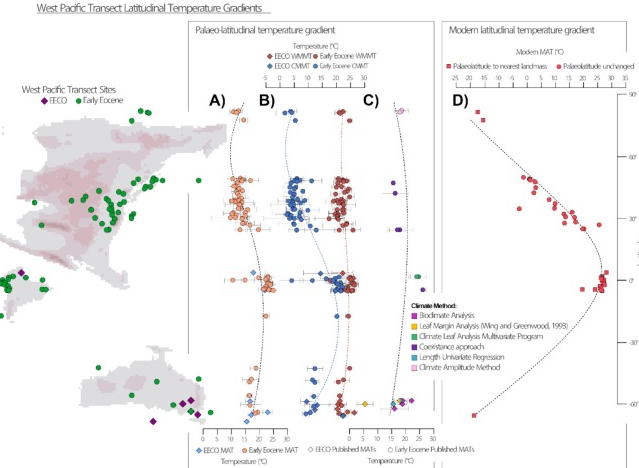
On the contrary, there will be fewer daily, latitudinal, and seasonal temperature fluctuations! After all, weather disasters are largely a result of temperature gradients, and there will be MUCH fewer of them.
Moreover, the same rain is perceived and causes damage differently at near-zero and +15 °C.
The number of frosts, hail, snowfalls, and droughts will also decrease. Even at the poles we had above zero temperatures even in winter.
In other words, the number of adverse natural phenomena will DECREASE.
Argument #6 Ocean acidification (corals and fish will die). Again, NO.
Corals and fish have survived CO₂ levels orders of magnitude higher in the past. We won’t even come close to such CO₂ increases; we’d need to burn hydrocarbons for thousands more years.
On the contrary, corals will do GREAT! Because the main thing holding them back at the equator is TEMPERATURE—they are extremely sensitive to it.
Their habitable zone will grow (by multiples).
Here is a paper published in the Proceedings of the Royal Society B in 2006, titled "Diverse staghorn corals (Acropora) in high-latitude Eocene assemblages: implications for the evolution of modern diversity patterns of reef corals" (Wallace and Rosen, 2006). This paper focuses on the genus Acropora, which is one of the most diverse genera of reef-building corals today. The paper details localities of Acropora fossils from the Eocene found at high latitudes such as 49–51° N, which is well above their modern range (31° N–31° S).
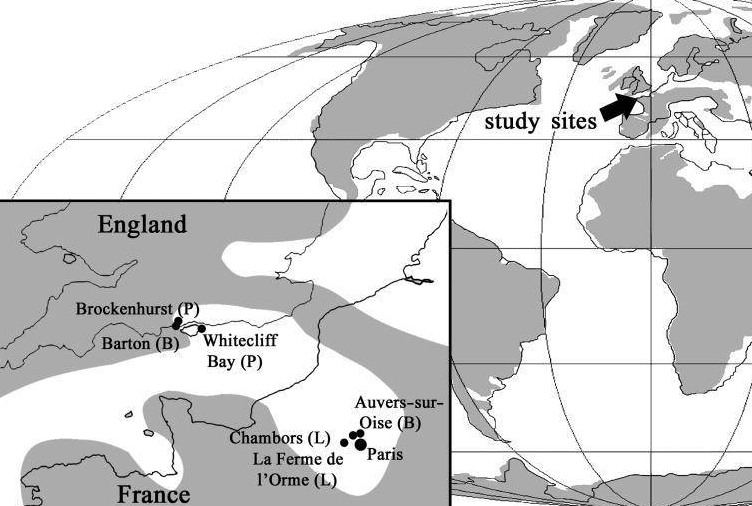
That is, in the Eocene they were so bad off that they even lived off the coast of England, and now their closest relatives are eking out an existence off the coast of West Africa. They've become acidic... yes...
Fish are a derivative of underlying ecosystems - the release of entire oceans from ice is a great boost for phytoplankton and everything higher up the food chain.
The fact that high levels of CO2 (up to 3000) do not harm ocean biota can be evidenced by https://whc.unesco.org/en/tentativelists/6539/ that 260 species of fish were found in just one area of the Eocene deposits, and this is only what was found tens of millions of years later and only in one area! And this is after another mass extinction 66 million years ago.
So, some species will suffer, like some single-celled creatures with shells, in the depths of the ocean. But the main food chains begin with phytoplankton, corals and algae. They should benefit from both the huge increase in habitat and the increase in "food" in the form of CO2 in the water, just as the size of tree leaves has increased on land. And therefore the entire food pyramid above them will benefit.
Argument #7 We’re facing an irreversible climate change like Venus.
Oh, those storytellers. Earth has gone through CO₂ levels dozens of times higher than today, temperatures of 37 °C: https://www.nature.com/articles/s41598-024-76432-8
or 32 °C: https://www.science.org/content/article/500-million-year-survey-earths-climate-reveals-dire-warning-humanity.
And sometimes CO₂ concentrations were thousands of times higher than today, and about 500 million years ago (i.e., a time with life on the planet, and not just life, but the Cambrian explosion, when a huge number of new species appeared), the difference from today’s concentration was 26 times.

Does anyone see Venus around?
500 °C has never happened in Earth’s history, but the opposite has—complete freezing.
Overall, it’s currently 6 °C colder than the average on Earth throughout its history. And the last 50 million years show a clear trend toward further temperature decline.

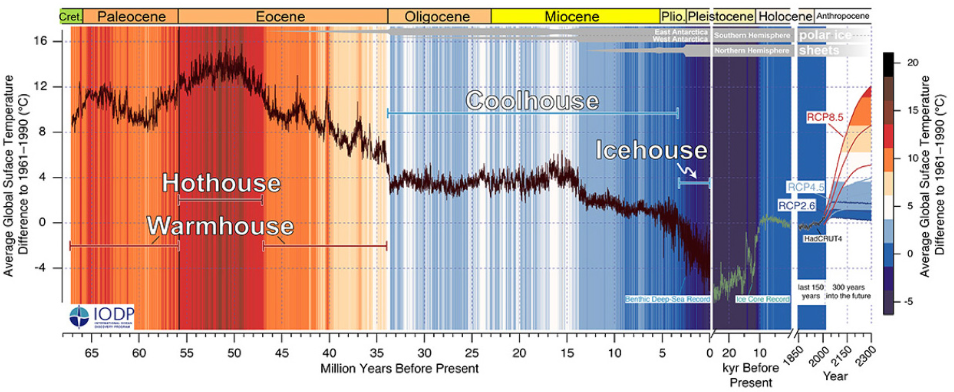
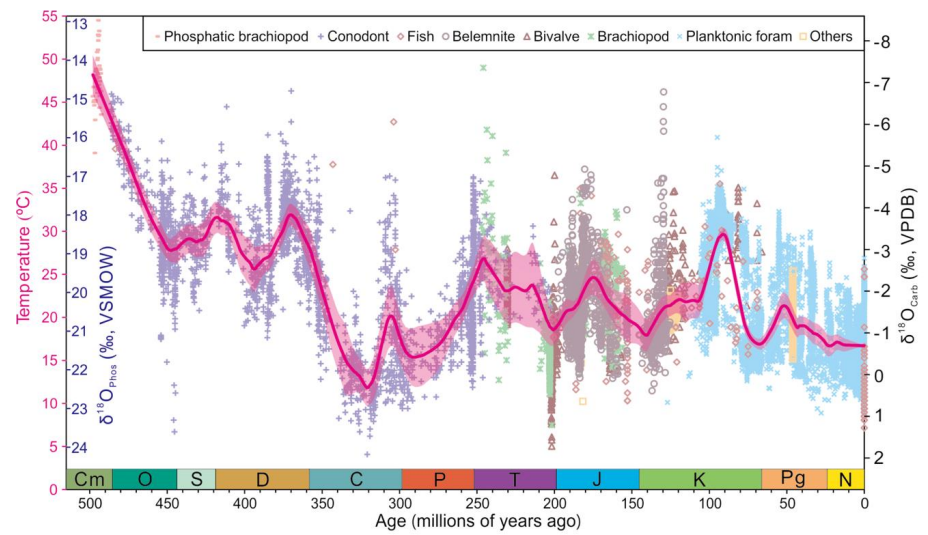
We shouldn’t fear “Venus” but Mars. Earth completely froze at least twice during the “Snowball Earth” events in the Neoproterozoic era (720–635 million years ago), including the Sturtian and Marinoan glaciations. There’s evidence of a possible third event, the Kaigas glaciation, though its global extent is debated. There’s also the Huronian glaciation 2.5–2.2 billion years ago, but its status is controversial. Thus, the number of global glaciations ranges from two to four. And how many smaller but extremely destructive ones for the biosphere…
The Earth is currently experiencing temperatures similar to those after the asteroid impact with the subsequent Impact Winter. I would call such temperatures catastrophic.
https://eprints.whiterose.ac.uk/id/eprint/169823/1/Scotese_etal_phan_temp_AAM.pdf?utm_source=chatgpt.com
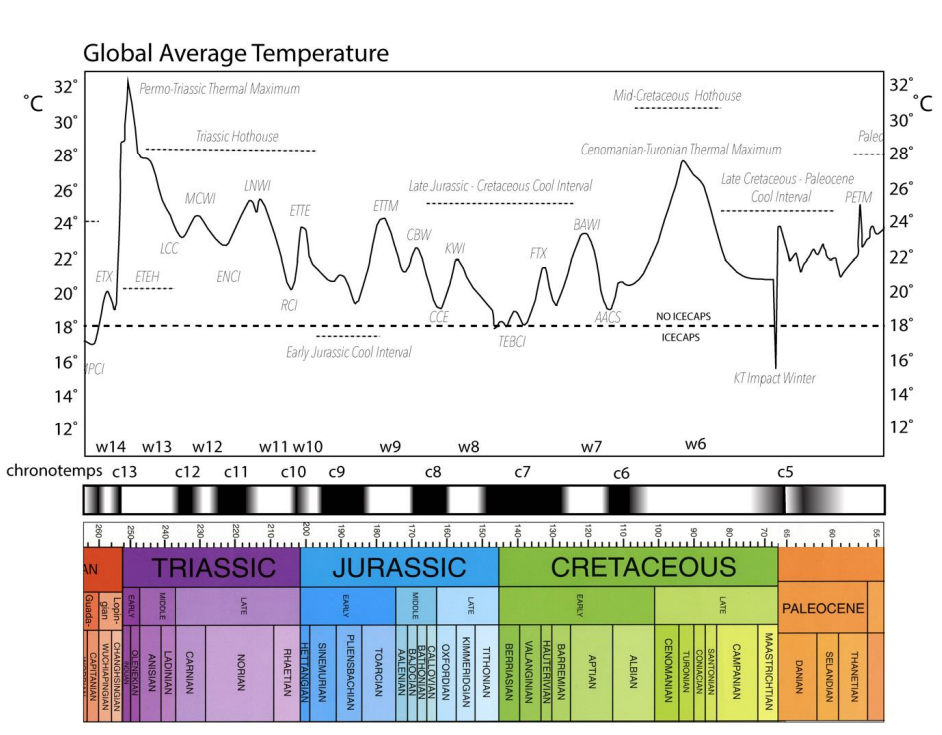
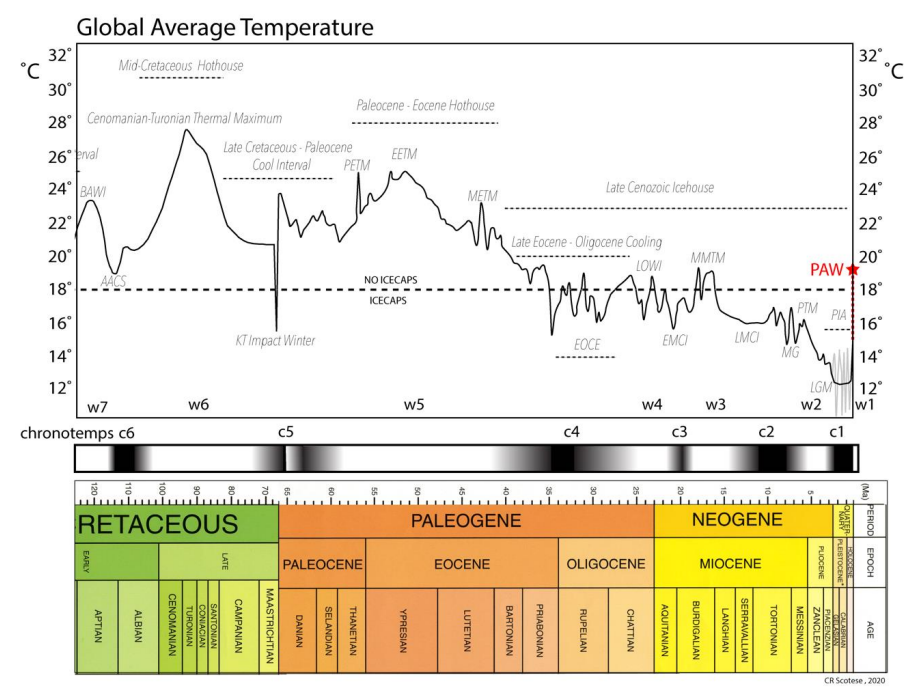
Argument #8 The economy will suffer.
No. Quite the opposite. How climate affects the economy can be read in the book Why Russia Is Not America, which thoroughly analyzes the impact of climate on the economy.
Just reducing the number of zero-crossing temperature transitions across most of Earth’s territory will add +N years of life to all human structures.
Fertility will significantly increase. This is due to expanded areas, longer growing seasons, precipitation, and rising CO₂ in the atmosphere.
https://bmcecol.biomedcentral.com/articles/10.1186/s12898-016-0082-z
20% yield in greenhouses
https://horticulture.ahdb.org.uk/knowledge-library/co2-best-practice-guide-background

Experiments like Free-Air Carbon Enrichment (FACE) show that elevated CO₂ levels can increase crop yields by 12–14% for crops like wheat, rice, and soybeans due to enhanced photosynthesis and water use efficiency.
Other studies suggest an increase of up to 35%
https://bmcplantbiol.biomedcentral.com/articles/10.1186/s12870-019-1788-9
About water. Precipitation varies by climatic zone:
-
Tropics: For tropical rainforests (Af) — 2000–10,000 mm (79–394 inches).
-
Temperate Zone: From 750 to 2032 mm (30–80 inches), depending on the subtype, e.g., humid subtropics (Cfa) or oceanic climate (Cfb).
-
Polar Zones: Less than 250 mm (10 inches) for tundra (ET), down to 100 mm (4 inches) for glacial zones (EF), with some coastal areas up to 1250 mm (49 inches).
Data based on NASA Study and Britannica Study.
If most of the Earth becomes tropics, the evaporation area will increase, a significant portion of ice will melt, and arid regions will decrease.
And this is only what can be easily found on the Internet in 1-2 working days. Imagine what can be done with all the arguments of the opponents of global warming, if you spend the same number of millions of dollars, only not on the propaganda of savagery, but on normal scientific meta-research.
Thus, I haven’t seen a single strong argument against warming. All this can (and should) be discussed with specific models, but at first glance, it’s clear that yes, there will be some local downsides, BUT OVERALL, both the planet and humanity will gain far more benefits from warming.
| Object Name | Utility/Cost | Utility | Cost | Notes | Interest of Alternative Energy Producers (5% weight) | Interest of Alternative Energy Producers (Description) | Most Comfortable Climate for Humans (10% weight) | Most Comfortable Climate for Humans (Description) | Polar Bears Will Disappear (5% weight) | Polar Bears Will Disappear (Description) | Many Species of Animals and Plants Will Go Extinct (10% weight) | Many Species of Animals and Plants Will Go Extinct (Description) | Sea Level Rise – Millions of People Will Be Forced to Migrate (5% weight) | Sea Level Rise – Millions of People Will Be Forced to Migrate (Description) | Natural Disasters (5% weight) | Natural Disasters (Description) | Decrease in "Favorable" Weather Days (10% weight) | Decrease in "Favorable" Weather Days (Description) | Ocean Acidification (Corals and Fish Will Die) (5% weight) | Ocean Acidification (Corals and Fish Will Die) (Description) | This Could Lead to Landslides and Increased Seismic and Volcanic Activity (5% weight) | This Could Lead to Landslides and Increased Seismic and Volcanic Activity (Description) | Irreversible Climate Change Like Venus (10% weight) | Irreversible Climate Change Like Venus (Description) | Increase in Violence Levels (5% weight) | Increase in Violence Levels (Description) | Decrease in Crop Yields (10% weight) | Decrease in Crop Yields (Description) | WHO States That Climate Change Affects Social and Environmental Health Factors, Such as Clean Air, Safe Drinking Water... (5% weight) | WHO States That Climate Change Affects Social and Environmental Health Factors, Such as Clean Air, Safe Drinking Water... (Description) | Economy (10% weight) | Economy (Description) |
|---|---|---|---|---|---|---|---|---|---|---|---|---|---|---|---|---|---|---|---|---|---|---|---|---|---|---|---|---|---|---|---|---|
| For Global Warming | 0.00 | 4.00 | 0.00 | 5 | Yes, it exists. | 4 | Currently, the average temperature on Earth is 14-15°C, but 20-30°C is required. There are studies that say the maximum productivity is at 22-23°C. Again, these studies were probably conducted on people in regular clothing. But most people prefer to move around not in suits and shoes but in shorts, a t-shirt, and flip-flops. So, the optimum for a lightly dressed person is probably 25-27°C. | 4 | They won't disappear; the maximum damage is caused by humans, not climate change. There will still be plenty of territory for bears to inhabit. There are studies showing that warming does not harm them. | 4 | On the contrary, there will be even more. Because a huge number of new ecological niches will appear under a more favorable temperature regime. The maximum number of species lives precisely in the equatorial zone. It's enough to look at the map from the Eocene http://www.sivatherium.narod.ru/library/Climate/glava_01.htm#pic_003 to understand that there will be many more species. Moreover, humans can preserve some of the most valuable endangered species in zoos. And some can simply be restored through genetic reconstruction, as is already being done now. Note: The Eocene (56–33.9 million years ago) was an era of significant warming, especially during the Early Eocene Climatic Optimum (EECO, 54–49 million years ago). The climate was warmer than today, with a global average temperature of about 27°C, and polar regions were ice-free. Tropical and subtropical conditions extended to high latitudes, as reflected in paleogeographic maps. | 4 | The rise is so slow that technological progress will have a much greater impact on migration. Moreover, active migration is beneficial for the internalization of people. The current rate of sea level rise is about 3.6 mm per year, and it is accelerating due to melting glaciers and thermal expansion of water. Projections for 2125 (100 years from now) depend on emission scenarios: with low emissions, the level may rise by 0.3 meters, and with high emissions and rapid glacier melting—up to 2–3 meters. The rate of infrastructure obsolescence is much faster, not to mention moral obsolescence. The discovery of new territories due to climate improvement will likely cover this land shortage. |
3 | On the contrary, there will be fewer daily and seasonal temperature fluctuations; there will be fewer disasters. The number of frosts, hail, snowfalls, and droughts will decrease. | 4 | The study was conducted incorrectly; for humans, the favorable range is 20-24°C, not 18-30°C. Also, there is an error in the rigid filters; it is necessary to calculate a single index of favorability, not zones limited by rigid filters, which indicates the researchers' interest in results against warming. | 5 | Corals have survived CO2 levels 12 times higher in the past. Also, their habitable zone will grow (by multiples). | 3 | Landslides will happen anyway. A slight increase in landslides is not a threat. Tsunamis from them are nonsense. Volcanism is even more nonsense. | 5 | There have been no precedents in Earth's history, but there have been the opposites—complete freezing. Overall, it is currently 6°C colder than the average on Earth throughout its history. And there is a trend towards freezing. See https://cs8.pikabu.ru/post_img/big/2016/10/11/4/1476161920122290871.png Earth probably completely froze at least twice during the "Snowball Earth" events in the Neoproterozoic era (720–635 million years ago), including the Sturtian and Marinoan glaciations. There is evidence of a possible third event, the Kaigas glaciation, although its global extent is debated. Also mentioned is the Huronian glaciation 2.5–2.2 billion years ago, but its status is controversial. Thus, the number varies from two to four, depending on the interpretation. |
1 | It is not clear how other factors were processed, whether the dynamics are preserved over long periods, and whether there is a connection with the type of economy. | 4 | On the contrary, there will be an increase in yields (there are experiments as well). Experiments such as Free-Air Carbon Enrichment (FACE) show that elevated CO2 levels can increase crop yields by 12–14% for crops such as wheat, rice, and soybeans due to increased photosynthesis and water use efficiency. And this is not to mention that almost all land will become fertile due to an increase in the growing season and precipitation. Precipitation varies depending on climatic zones: - Tropics: For tropical rainforests (Af) — 2000–10,000 mm (79–394 inches), for savannas (Aw/As) — 500–1500 mm (20–59 inches). - Temperate zone: From 750 to 2032 mm (30–80 inches), depending on the subtype, for example, humid subtropics (Cfa) or oceanic climate (Cfb). - Polar zones: Less than 250 mm (10 inches) for tundra (ET), down to 100 mm (4 inches) for glacial zones (EF), with some coastal areas up to 1250 mm (49 inches). Data based on NASA studies and Britannica classification. |
4 | Is this a statement or a study? On the contrary, the amount of precipitation will improve the water situation; warming will reduce the load on infrastructure and increase housing construction. | 4 | Read the book "Why Russia Is Not America" and understand that warmth is a blessing for the economy | |
| Against Global Warming | 0.00 | -0.45 | 0.00 | 4 | 0 | 0 | 1 | None | 1 | None | 1 | None | 1 | None | 1 | Local die-offs in lagoons are possible. | -4 | Among about 1000 existing programs for calculating landslides, none can provide a forecast. | -5 | None | 1 | None | -4 | None | 1 | Local deteriorations are possible | 0 | None |